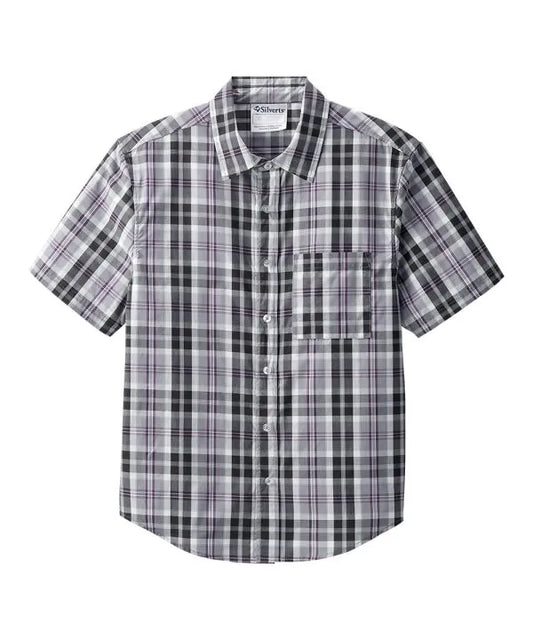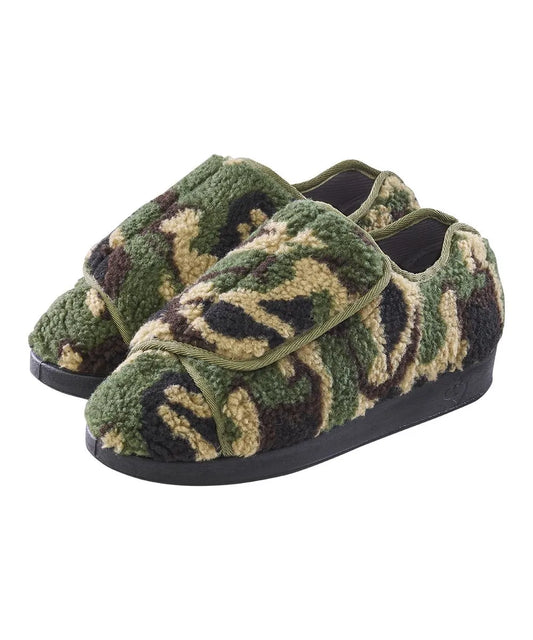Written by: Tara Chen
Getting dressed is one of the most frequent difficulties that people with Parkinson's disease face when going about their daily lives. A basic button or zipper can become a frustrating barrier due to tremors, stiffness, and decreased dexterity. Fortunately, adaptive apparel provides comfortable and useful ways to help people stay independent while making dressing easier. Below, we look at various brands, dressing aids, and clothing features that can help make living with Parkinson's disease a little easier.
Magnetic Buttons Vs. Velcro: Which Works Better?
Adaptive closures are revolutionary when hand tremors or rigidity make zipping and buttoning a shirt challenging. Velcro fasteners and magnetic buttons are two of the most widely used options. Depending on individual preferences and the severity of symptoms, each has special advantages.
Magnetic Buttons
People with Parkinson's disease who are in the early to moderate stages frequently favour magnetic closures. For instance, June Adaptive offers a Women’s Shirt with Magnetic Buttons, which is ideal for those with limited dexterity. For people who struggle with accuracy but still have some hand control and mobility, these buttons are perfect.

Advantages:
-
Look like regular buttons: Usually concealed behind fabric or designed to look like regular buttons, magnetic closures have a conventional appearance. They are therefore particularly appealing to people who wish to keep up a polished or businesslike appearance.
-
Dressing with little effort: Magnetic closures make dressing quicker and less annoying because buttonholes don't need to line up. This removes any frustration that is typically involved with having to fasten traditional buttons.
-
Minimal coordination required: All you have to do is bring the garment's two sides together. No threading, pinching, or twisting is required because the magnets will "click" into position.
-
Excellent for formal attire: Dress shirts, blouses, and lightweight jackets with magnetic fastenings make it easy to look elegant and are perfect for religious services, social gatherings, and the workplace.
-
Machine washable options available: Nowadays, a lot of companies produce machine-safe magnetic clothing, which eliminates the need for dry cleaning or delicate hand washing.
Considerations:
-
May move if improperly aligned: The majority of magnetic closures are robust, but if they are pulled too tightly or are not aligned properly, some may move slightly or pop open.
-
Unsuitable for bulky outerwear: Magnets may not offer as much hold as Velcro or zippers in jackets that are thick or structured.
Velcro
For those with severe tremors or more severe mobility issues, Velcro closures are revolutionary. Velcro is one of the easiest closure methods to use because it doesn't require any fine motor skills. For example, the Men’s Adaptive Swim Short from June Adaptive features Velcro for effortless self-dressing.

Advantages:
-
Quick and simple to use: With just one hand, Velcro can be attached and removed. There is no need to align, twist, or pinch.
-
Perfect for people with severe tremors or diminished strength: Velcro's ease of use is frequently advantageous for people recuperating from surgery or in more advanced stages of Parkinson's disease.
-
Ideal for casual and home attire: Cardigans, slippers, sweatsuits, and everyday tops with Velcro are excellent for light household chores or relaxation.
-
High degree of adjustability: Velcro makes it possible to change the fit and size, which is particularly useful if you have edema or varying mobility throughout the day.
-
Available in shirts, pants, shoes, and other items: It's now easier than ever to get dressed with confidence thanks to adaptive fashion brands that use Velcro in more than just shoes.
Considerations:
-
Might cling to textiles: Over time, Velcro may cause damage or pilling because it adheres to soft materials like fleece or knits.
-
More noticeable: Velcro strips are frequently bulkier and more noticeable than hidden magnetic closures, which may be an issue for people who would rather look discrete.
-
May eventually wear out: Velcro may become less sticky with repeated washings and use. After prolonged use, worn-out strips might need to be replaced.
Overall, a lot of people discover that a combination works best. Velcro provides the quickest option for clothing worn at home or during exercise, while magnetic buttons can help everyday outfits feel "normal." Frequently, the decision involves striking a balance between desired style and ease of use.
Best Weighted Clothing For Stability
People with Parkinson’s frequently worry about stability and balance, particularly as their mobility varies over time. Proprioception and coordination can be improved with weighted clothing, which includes small weights in wristbands, ankle supports, or vests.
Weighted vests are especially helpful for people who frequently have trouble balancing or walking steadily. The weights' mild pressure creates sensory feedback that can lessen uncontrollable movements and give the body a sense of stability. Vests that are both lightweight enough for daily use and resistant enough to maintain stability are being produced by adaptive fashion brands.
For people with hand tremors, weighted gloves or cuffs may also be helpful. By providing a small amount of resistance, these can occasionally lessen excessive movement, though they are not intended to totally eliminate tremors. To enhance motor control, some occupational therapists might advise wearing weighted clothing during exercises or everyday tasks.
Before using weighted clothing, it's crucial to speak with a healthcare provider to make sure the items are suitable and safe. If not fitted properly, excessively heavy clothing can impair gait or cause fatigue. Nowadays, a lot of companies sell weighted vests and clothing that can be adjusted in weight according to comfort and therapeutic objectives.
How To Choose Non-Restrictive Yet Secure Outfits
It can be challenging to find apparel that balances security and comfort. While looser clothing may feel unstable or unsafe, symptoms of Parkinson's may make certain fabrics or fits feel restrictive. Selecting adaptive apparel that permits mobility without sacrificing safety is the aim.
First, consider the fabric of the garment:
-
Select materials that are not too slippery but have some stretch.
-
The best materials for softness and ease of movement are moisture-wicking materials, cotton blends, and soft knits.
-
Stretch fabrics promote natural movement and help with tremors or stiffness.
-
Steer clear of materials that are too rigid or stiff because they can restrict movement, cause chafing, and make dressing exhausting.
-
Denim and heavy wool are examples of fabrics that can cause discomfort.
-
Lightweight, breathable materials aid in controlling body temperature.
Second, inspect the fit of the garment:
-
Choose clothing that fits slightly loosely so that you can bend, reach, and twist.
-
Free-flowing clothing shouldn't be too loose or dangerous.
-
Compared to button-and-zip styles, pants with adjustable side openings or elastic waistbands are simpler. For example, June Adaptive offers a pair of Men’s Seated Stretch Cargo Pants with an Elastic Waistband.

-
Slip-on pants make dressing easier.
-
Shoulder and arm strain is lessened by tops with side zippers or raglan sleeves.
-
Draping that is comfortable reduces the chance of snagging on furniture or tripping.
Third, pay attention to the closure style:
-
Clothing with an open front is the easiest to handle.
-
Make sure the fasteners are strong enough to withstand bending, sitting, and walking.
-
Adaptive pants with Velcro or magnetic fastenings will likely help you feel more secure and comfortable.
-
Adjustable straps, overlapping panels, and wide openings offer comfort and security.
Top Brand For Parkinson’s-Friendly Fashion
As the market for adaptive apparel has expanded, a number of companies have surfaced that focus on fashionable yet practical options for people with mobility impairments. A well-known retailer that specializes in inclusive fashion for the elderly and disabled is June Adaptive. They have wide-opening shoes, side-zip pants, and magnetic button shirts that are ideal for people who are stiff or tremble. With a variety of styles for both men and women, you can easily find an article of clothing that is suitable for your needs.
Dressing Aids To Maintain Independence
Even though adaptive apparel can have a significant impact, combining it with basic dressing assistance can increase independence even more. These devices are made to help with everyday dressing duties that become difficult when a person has hand weakness or tremors.
-
Button hooks and zipper pulls: If you’re not ready to make the complete transition to adaptive clothing, traditional solutions like button hooks and zipper pulls can help you manage regular clothing. A button hook is a tiny handle with a wire loop that pulls the button through the buttonhole with minimal finger dexterity.
-
Long-handled shoehorns: With the help of long-handled shoehorns, you can put on shoes without stooping too much or fumbling with laces. When combined with Velcro or adaptive slip-on shoes, this greatly simplifies footwear management.
-
Sock aids: Another useful tool are sock aids, particularly for people who have leg or back stiffness. In order to allow the foot to slide in without requiring excessive bending or stretching, these devices hold the sock open.
-
Dressing sticks: Dressing sticks can help people who still like wearing traditional clothes but wish to be independent and put on jackets, pants, or other clothing without excessive strain. These tools lower the chance of falls due to awkward movements.
When dressing aids and adaptive apparel are used together, people with Parkinson's disease can maintain their independence for as long as possible. Confidence and general quality of life are greatly impacted by maintaining independence in daily tasks.
Conclusion
Dressing doesn't have to be a daily struggle. Weighted clothing, dressing aids, and adaptive apparel can change the daily experience of getting ready. People can preserve their independence and self-confidence in their appearance by choosing products that blend comfort, style, and functionality.
There are now more options than ever before for Parkinson's-friendly fashion, whether you're looking for weighted clothing for added stability, Velcro closures for maximum ease, or magnetic buttons for a polished appearance. Dressing is made safe and empowering by emphasizing secure closures, soft materials, and non-restrictive fits. Living well with Parkinson's becomes a little more comfortable and much more fashionable with the correct clothing and equipment.
To discover more adaptive fashion and accessible solutions, sign up for the June Adaptive newsletter. You’ll get firsthand updates on the newest products and Parkinson’s-friendly styles.















